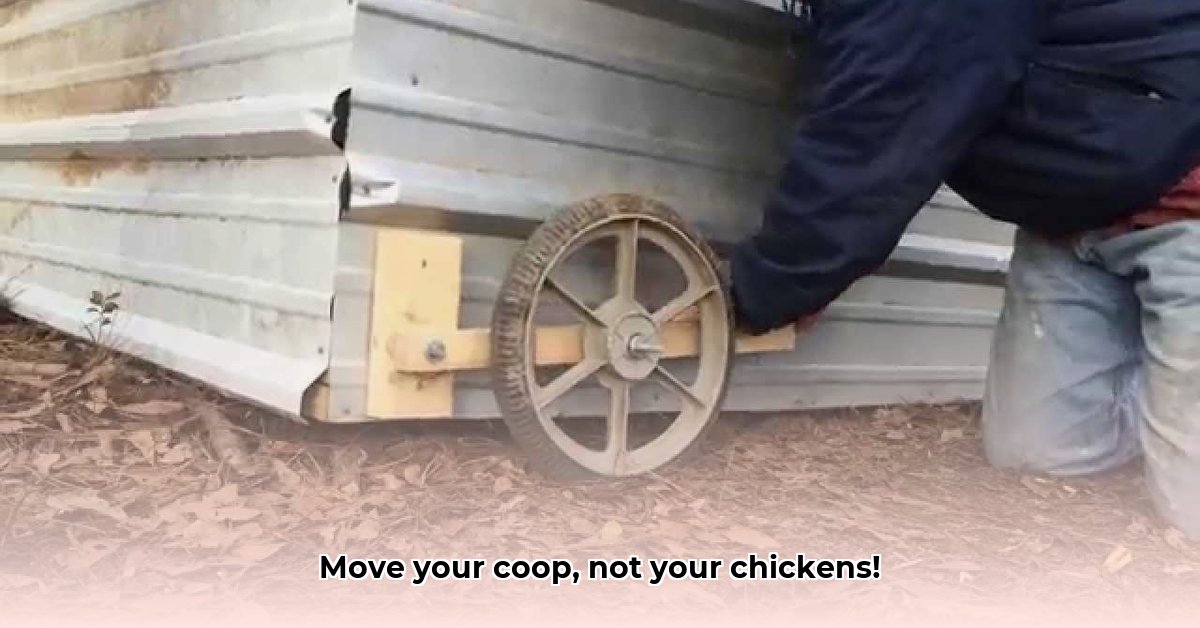
Ready to upgrade your chicken-keeping game? Building a mobile coop, or chicken tractor, offers numerous benefits, from improving pasture health to simplifying chicken management. But true mobility hinges on a well-designed wheel system. This guide provides step-by-step instructions for building both fixed and adjustable wheel systems, complete with a comparative review to help you choose the best option for your needs and budget. Let's roll! For even more design ideas, check out these free chicken tractor plans.
Choosing Your Wheel System: Fixed vs. Adjustable
Before diving into construction, you need to decide between fixed and adjustable wheels. Each has its strengths and weaknesses:
| Feature | Fixed Wheels | Adjustable Wheels |
|---|---|---|
| Cost | Lower initial investment | Higher upfront cost |
| Complexity | Easier installation; fewer parts | More complex installation; more moving parts |
| Adjustability | No height adjustment; fixed height | Easily adjust height to suit terrain |
| Maneuverability | Limited; best for smaller, lighter coops | Greater flexibility; ideal for larger coops and uneven ground |
| Maintenance | Less frequent maintenance needed | Requires more regular maintenance; moving parts may wear out |
| Predator Risk | Potentially higher due to limited maneuverability | Can be minimized with careful design and added protection |
Fixed wheels are a budget-friendly option, perfect for smaller, lighter coops and simpler terrains. They're easy to install and require less maintenance. However, their lack of adjustability limits maneuverability, especially on uneven ground. Adjustable wheels, while more expensive, offer superior versatility, making them ideal for larger coops and challenging terrains. They are also easier to adjust for predator protection. But, their increased complexity means more potential maintenance.
Building Fixed Chicken Tractor Wheels: A Step-by-Step Guide
This section details building fixed wheels – a great starting point for beginners.
Materials List:
- Four heavy-duty wheels (8" to 10" diameter recommended; solid rubber is durable) [Link to example online retailer]
- Four sturdy axle brackets (rated for at least twice your coop's weight) [Link to example online retailer]
- Bolts, washers, and nuts (galvanized steel, appropriate size for brackets and wheels) [Link to example online retailer]
- Wood for reinforcement (2x4 pressure-treated lumber, sufficient length) [Link to example online retailer]
Tool List:
- Drill with appropriate drill bits
- Measuring tape
- Saw (circular saw recommended)
- Wrench set
- Level
Safety Precautions: Always wear safety glasses and appropriate work gloves.
Step-by-Step Instructions:
Measure and Mark: Carefully measure your coop and mark the wheel attachment points. Ensure even spacing for balance.
Attach Brackets: Securely attach the axle brackets to the coop frame using bolts, washers, and nuts. Use a level to ensure alignment. Tighten securely to avoid shifting.
Install Wheels: Mount the wheels onto the axles and tighten everything securely. Double-check all connections for stability.
Reinforce: Add wood supports to reinforce the wheel assembly, distributing weight evenly to prevent stress on the coop frame.
Building Adjustable Chicken Tractor Wheels: A More Advanced Project
Adjustable wheels provide greater flexibility but require more advanced skills and materials.
Materials List:
- Heavy-duty wheels (10" to 12" diameter recommended; pneumatic wheels are best for uneven terrain) [Link to example online retailer]
- Metal tubing for axles (or consider a pre-made caster wheel kit) [Link to example online retailer]
- Heavy-duty hinges (rated for significant weight) [Link to example online retailer]
- Threaded rods and nuts (for height adjustment) [Link to example online retailer]
- Bolts, washers, and nuts (galvanized steel, appropriate sizes) [Link to example online retailer]
Tool List:
- Welding equipment (if making custom axles)
- Drill with appropriate drill bits
- Measuring tape
- Saw (metal cutting saw if using metal tubing)
- Wrench set
- Level
- Angle grinder (optional, for metal work)
Step-by-Step Instructions (General Outline):
Design: Plan your axle system. Consider using a pre-assembled caster wheel kit to simplify the project.
Assemble Axles: Construct or assemble the axle system; welding may be necessary for custom solutions.
Attach Hinges: Securely attach the axles to the coop frame using heavy-duty hinges.
Install Wheels: Mount the wheels onto the axles.
Add Height Adjustment: Install threaded rods and nuts to allow for height adjustments and leveling of the coop.
Note: This is a more complex project; consult online tutorials or seek help from experienced builders if needed.
Predator Protection and Chicken Tractor Maintenance
Regardless of wheel type, predator protection is paramount. Consider these strategies:
Hardware Cloth Skirt: Bury hardware cloth (1/2" mesh minimum) around the coop's perimeter, several inches below ground level, to deter digging predators.
Elevated Coop: Ensure sufficient ground clearance to deter smaller predators.
Regular Inspection: Regularly inspect the coop and wheel system for any damage or looseness.
Remember, building a chicken tractor wheel system is a rewarding experience. Choosing the appropriate wheel system and implementing robust predator protection will provide your chickens with a safe and mobile home. Happy building!